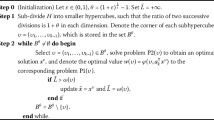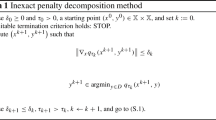Abstract
We consider the problem of decomposing a multivariate polynomial as the difference of two convex polynomials. We introduce algebraic techniques which reduce this task to linear, second order cone, and semidefinite programming. This allows us to optimize over subsets of valid difference of convex decompositions (dcds) and find ones that speed up the convex–concave procedure. We prove, however, that optimizing over the entire set of dcds is NP-hard.



Similar content being viewed by others
Notes
For a strongly NP-hard problem, even a pseudo-polynomial time algorithm cannot exist unless P=NP [16].
If we do not add the condition on the input that \(f\ne g\), the problem would again be NP-hard (in fact, this is even easier to prove). However, we believe that in any interesting instance of this question, one would have \(f\ne g\).
Note that \(\text{ Tr } H_h({\bar{x}})\) (resp. \(\lambda _{\max } H_h({\bar{x}})\)) gives the average (resp. maximum) of \(y^TH_h({\bar{x}})y\) over \(\{y~|~||y||=1\}\).
A variant of this proposition in the quadratic case appears in [9, Proposition 12].
References
Ahmadi, A.A., Majumdar, A.: DSOS and SDSOS optimization: LP and SOCP-based alternatives to sum of squares optimization. In: Proceedings of the 48th Annual Conference on Information Sciences and Systems. Princeton University (2014)
Ahmadi, A.A., Majumdar, A.: DSOS and SDSOS optimization: more tractable alternatives to sum of squares and semidefinite optimization. In preparation (2017)
Ahmadi, A.A., Olshevsky, A., Parrilo, P.A., Tsitsiklis, J.N.: NP-hardness of deciding convexity of quartic polynomials and related problems. Math. Progr. 137(1–2), 453–476 (2013)
Ahmadi, A.A., Parrilo, P.A.: A convex polynomial that is not sos-convex. Math. Progr. 135(1–2), 275–292 (2012)
Ahmadi, A.A., Parrilo, P.A.: A complete characterization of the gap between convexity and sos-convexity. SIAM J. Optim. 23(2), 811–833 (2013). Also arXiv:1111.4587
Alizadeh, F., Goldfarb, D.: Second-order cone programming. Math. Progr. 95(1), 3–51 (2003)
Alvarado, A., Scutari, G., Pang, J.: A new decomposition method for multiuser dc-programming and its applications. Signal Process. IEEE Trans. 62(11), 2984–2998 (2014)
Argyriou, A., Hauser, R., Micchelli, C.A., Pontil, M.: A DC-programming algorithm for kernel selection. In: Proceedings of the 23rd International Conference on Machine Learning, pp. 41–48. ACM (2006)
Bomze, I., Locatelli, M.: Undominated dc decompositions of quadratic functions and applications to branch-and-bound approaches. Comput. Optim. Appl. 28(2), 227–245 (2004)
Chapelle, O., Do, C.B., Teo, C.H., Le, Q.V., Smola, A.J.: Tighter bounds for structured estimation. In: Advances in Neural Information Processing Systems, pp. 281–288 (2009)
de Klerk, E., Laurent, M.: On the Lasserre hierarchy of semidefinite programming relaxations of convex polynomial optimization problems (2010). http://www.optimization-online.org/DB-FILE/2010/11/2800.pdf
Dür, M.: A parametric characterization of local optimality. Math. Methods Oper. Res. 57(1), 101–109 (2003)
Floudas, C., Pardalos, P.: Optimization in Computational Chemistry and Molecular Biology: Local and Global Approaches, vol. 40. Springer, New York (2013)
Folland, G.: How to integrate a polynomial over a sphere. Am. Math. Month. 108(5), 446–448 (2001)
Fung, G., Mangasarian, O.: Semi-supervised support vector machines for unlabeled data classification. Optim. Methods Softw. 15(1), 29–44 (2001)
Garey, M.R., Johnson, D.S.: Computers and Intractability. W. H. Freeman and Co., San Francisco (1979)
Gulpinar, N., Hoai An, L.T., Moeini, M.: Robust investment strategies with discrete asset choice constraints using DC programming. Optimization 59(1), 45–62 (2010)
Hartman, P.: On functions representable as a difference of convex functions. Pac. J. Math 9(3), 707–713 (1959)
Helton, J.W., Nie, J.: Semidefinite representation of convex sets. Math. Progr. 122(1), 21–64 (2010)
Hilbert, D.: Über die Darstellung Definiter Formen als Summe von Formenquadraten. Math. Ann. 32, 342–350 (1888)
Hillestad, R., Jacobsen, S.: Reverse convex programming. Appl. Math. Optim. 6(1), 63–78 (1980)
Hiriart-Urruty, J.B.: Generalized differentiability, duality and optimization for problems dealing with differences of convex functions. In: Convexity and Duality in Optimization, pp. 37–70. Springer (1985)
Hoai An, L.T., Le, H.M., Tao, P.D., et al.: A DC programming approach for feature selection in support vector machines learning. Adv. Data Anal. Classif. 2(3), 259–278 (2008)
Hoai An, L.T., Tao, P.D.: Solving a class of linearly constrained indefinite quadratic problems by dc algorithms. J. Glob. Optim. 11(3), 253–285 (1997)
Horst, R., Thoai, N.: DC programming: overview. J. Optim. Theory Appl. 103(1), 1–43 (1999)
Lanckriet, G., Sriperumbudur, B.: On the convergence of the concave–convex procedure. In: Advances in Neural Information Processing Systems, pp. 1759–1767 (2009)
Lasserre, J.B.: Convexity in semialgebraic geometry and polynomial optimization. SIAM J. Optim. 19(4), 1995–2014 (2008)
Ling, C., Nie, J., Qi, L., Ye, Y.: Biquadratic optimization over unit spheres and semidefinite programming relaxations. SIAM J. Optim. 20(3), 1286–1310 (2009)
Lipp, T., Boyd, S.: Variations and extensions of the convex–concave procedure (2014). http://web.stanford.edu/~boyd/papers/cvx_ccv.html
Lou, Y., Osher, S., Xin, J.: Computational aspects of constrained \(l_1-l_2\) minimization for compressive sensing. In: Modelling, Computation and Optimization in Information Systems and Management Sciences, pp. 169–180. Springer (2015)
Magnani, A., Lall, S., Boyd, S.: Tractable fitting with convex polynomials via sum of squares. In: Proceedings of the 44th IEEE Conference on Decision and Control (2005)
Megretski, A.: SPOT: systems polynomial optimization tools (2013)
MOSEK Reference Manual: Version 7. Latest version http://www.mosek.com/ (2013)
Parrilo, P.A.: Structured semidefinite programs and semialgebraic geometry methods in robustness and optimization. Ph.D. thesis, California Institute of Technology (2000)
Parrilo, P.A.: Semidefinite programming relaxations for semialgebraic problems. Math. Progr. 96(2, Ser. B), 293–320 (2003)
Parrilo, P.A., Sturmfels, B.: Minimizing polynomial functions. Algor. Quant. Real Algebr. Geom. DIMACS Ser. Discrete Math. Theor. Comput. Sci. 60, 83–99 (2003)
Piot, B., Geist, M., Pietquin, O.: Difference of convex functions programming for reinforcement learning. In: Advances in Neural Information Processing Systems, pp. 2519–2527 (2014)
Reznick, B.: Some concrete aspects of Hilbert’s 17th problem. In: Contemporary Mathematics, vol. 253, pp. 251–272. American Mathematical Society (2000)
Salakhutdinov, R., Roweis, S., Ghahramani, Z.: On the convergence of bound optimization algorithms. In: Proceedings of the Nineteenth Conference on Uncertainty in Artificial Intelligence, pp. 509–516. Morgan Kaufmann Publishers Inc. (2002)
Tao, P.D., Hoai An, L.T.: Convex analysis approach to dc programming: theory, algorithms and applications. Acta Mathematica Vietnamica 22(1), 289–355 (1997)
Tao, P.D.: Duality in dc (difference of convex functions) optimization. Subgradient methods. In: Trends in Mathematical Optimization, pp. 277–293. Springer (1988)
Toland, J.: On subdifferential calculus and duality in non-convex optimization. Mémoires de la Société Mathématique de France 60, 177–183 (1979)
Tuy, H.: A general deterministic approach to global optimization via dc programming. N.-Holl. Math. Stud. 129, 273–303 (1986)
Tuy, H.: Global minimization of a difference of two convex functions. In: Nonlinear Analysis and Optimization, pp. 150–182. Springer (1987)
Tuy, H.: DC optimization: theory, methods and algorithms. In: Handbook of Global Optimization, pp. 149–216. Springer (1995)
Tuy, H., Horst, R.: Convergence and restart in branch-and-bound algorithms for global optimization. Application to concave minimization and dc optimization problems. Math. Progr. 41(1–3), 161–183 (1988)
Wang, S., Schwing, A., Urtasun, R.: Efficient inference of continuous markov random fields with polynomial potentials. In: Advances in Neural Information Processing Systems, pp. 936–944 (2014)
Yuille, A., Rangarajan, A.: The concave–convex procedure (CCCP). Adv. Neural Inf. Process. Syst. 2, 1033–1040 (2002)
Acknowledgements
We would like to thank Pablo Parrilo for insightful discussions and Mirjam Dür for pointing out reference [9].
Author information
Authors and Affiliations
Corresponding author
Additional information
The authors are partially supported by the Young Investigator Program Award of the AFOSR and the CAREER Award of the NSF.
Rights and permissions
About this article
Cite this article
Ahmadi, A.A., Hall, G. DC decomposition of nonconvex polynomials with algebraic techniques. Math. Program. 169, 69–94 (2018). https://doi.org/10.1007/s10107-017-1144-5
Received:
Accepted:
Published:
Issue Date:
DOI: https://doi.org/10.1007/s10107-017-1144-5
Keywords
- Difference of convex programming
- Conic relaxations
- Polynomial optimization
- Algebraic decomposition of polynomials




